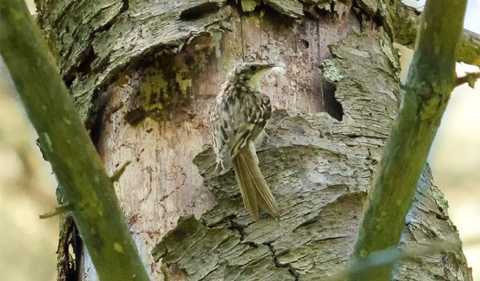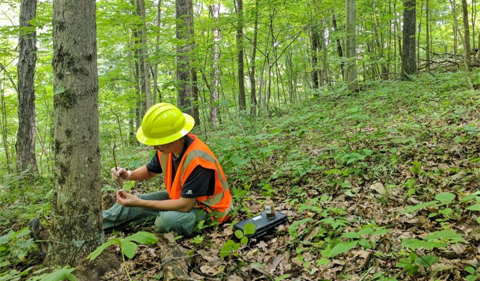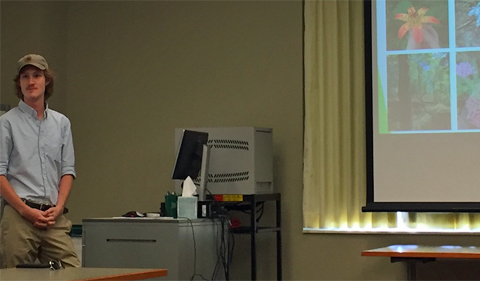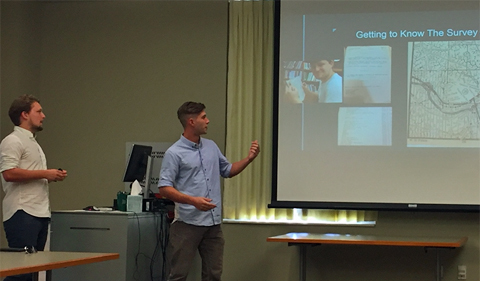
From left, students Devon Cottrill, Kyle Brooks, Trevor Somogyi, Sam Heckel, and Zachary Matthews
by Kristin Distel
Five students, several Ohio University faculty and staff members, and representatives from Wayne National Forest came together on Aug. 1 to mark the successful completion of internships conducted by students in the departments of Anthropology, Environmental & Plant Biology, and Biological Sciences.
The students shared photographs, major conclusions, highlights, and species findings from their respective internships, all of which were conducted at Wayne National Forest on the proposed Bailey Mountain Bike Trail.
Director of External Relations Lisa Cohen, who was integral to the implementation of the internship program, explained that the interns received excellent on-site training and job shadowing experience with Wayne employees.
‘A Robust Relationship That Serves Our Mutual Interests’
Dean of the College Arts and Sciences Dr. Robert Frank was in attendance and praised the mutually beneficial nature of the internship program.
“It has been our goal for a long time to work closer with people from Wayne National Forest. It is important for the university to take advantage of the opportunities provided by the Wayne.” He noted that Wayne National Forest is an ideal location in which both students and faculty can proactively help the community and “serve core mission of the Wayne.” Internships, he noted, are an ideal way to accomplish these goals.
Frank also explained that there is “a real alignment” between the students’ internship needs and meeting a demand that exists at Wayne National Forest. “This was a very ambitious undertaking, and I am grateful to everyone who has helped. I hope, with respect to internships, that this is the inauguration of all manner of relations between the Wayne and OHIO. It is a robust relationship that serves our mutual interests well,” Dean Frank added.

A female Brown Creeper perched atop her nest, which is placed underneath a piece of loose bark.
Photo Credit: Wayne National Forest – Ohio University Wildlife Intern Kyle Brooks
Wildlife Biology at the Wayne
Wildlife Biology students Devon Cottrill and Kyle Brooks conducted their internship along a thirty-mile section of Bailey Mountain Bike Trail. Their goal was to survey the existence of wildlife along the bike trail to determine whether the trail should be altered or moved to ameliorate negative effects on the area’s animals. To accomplish this, they conducted area surveys and random observations, performed a great deal of camera trapping, and baited trees with skunk-based lure.
Unsurprisingly, their cameras and other observations showed that deer were the most common animal found along the trail. However, they also confirmed the presence of:
- Red Foxes
- Gray Foxes
- Bobcats
- One Black Bear
- 72 species of birds
- 9 species of reptiles (particularly turtles and snakes)
- 9 species of amphibians
- Many insects, most notably Monarchs (a species of butterfly) and Blue Corporals (a species of dragonfly)
Five of the birds that Cottrill and Brooks observed are included on the State of North America’s Birds Watch List, which indicates that the species are in rapid decline. The highlight of their observations, the students note, was the presence of a pair of nesting Brown Creepers, which was the first-ever recorded breeding attempt of this species in Southeast Ohio. These Brown Creepers were not nesting in the proposed trail area, but instead were nesting approximately a mile away in another section of Wayne National Forest outside of Buchtel.
Their observations of insects were also fruitful. Cottrill and Brooks explained they found two previously undiscovered populations of Blue Corporals, a state-endangered dragonfly. Although these two new populations are near the proposed trail system, they are far enough away as to not be impacted.
Cottrill and Brooks want to emphasize that “There are always new species and new populations to be found,” and that the only way to make these discoveries is to “fund general surveying.”
In terms of their overall findings and the goal of their research, the students determined that the majority of the thirty-mile section they surveyed will not markedly affect the wildlife in the area. There were only a few sections of the trail, Brooks explained, that would be need to be slightly moved. These few sections of the trail happened to interfere with sensitive habitat features utilized by various animals, such as vernal pools or rock bluffs. Luckily these are an easy fix, as the trail would only need to be moved a couple dozen yards away. Brooks noted that the greatest impact on the wildlife in the area would come from any “increased vehicular traffic along the gravel roads,” which he said would “especially [impact] snakes, turtles, and amphibians.” Cottrill and Brooks made sure to explain that this is not a problem which can be fixed by an entity like Wayne National Forest, but instead can be fixed by members of the general public slowing down and stopping for wildlife species in the road. “I implore you to brake for the wildlife you see crossing the road,” Brooks said.

Devon Cottrill baiting a tree to attract mammals to a trail camera.
Photo Credit: Wayne National Forest – Ohio University Wildlife Intern Kyle Brooks
Cottrill and Brooks’s internship helped to shape and inform their long-term career goals.
“This internship showed me that what I envisioned for my career is different from what I expected and experienced this summer. I want to do outreach or perhaps explore the law enforcement side of conservation. Without this internship, I wouldn’t have reached this vision of my career,” Cottrill explained.
Brooks notes that the internship was especially useful in terms of teaching technical skills.
“It taught me a lot of survey methods that current jobs require. I didn’t have that experience before. I’m going to use all these skill sets for any of my future jobs,” he noted.
Lynda Andrews, Athens District Wildlife Biologist, noted that she was very impressed with the work that Cottrill and Brooks completed.
“I took them to The Wilds, and we helped reintroduce various species. These students were always willing to go out at night and do Whip-Poor-Will surveys. I was impressed with their dedication, and we got a quality product out of it,” Andrews remarked.
Botany at the Wayne
Botany students Trevor Somogyi and Emily Penn’s internship at Wayne National Forest also focused on a mountain bike trail survey. The students surveyed the trail and worked alongside Wayne botanist Jeffery Rebitzke “with the goal of updating data on current sensitive species, as well as monitoring watch-list species.”

Trevor Somogyi presents research from his internship.
Penn (who was unable to attend the presentation) and Somogyi assisted in the completion of anabat surveys, which involved driving a car with a powerful microphone attached to the vehicle with the goal of picking up bat calls.
“That was a blast,” Somogyi recalled. He also remarked that a highlight of the internship was the ability to put to tangible use the knowledge he has gained as a student at OHIO.
The student team located several Regional Forester Sensitive Species, including the Sparselobe Grapefern (Botrychium biternatum), which requires state botanists to examine and verify, as well as 200 Yellow Gentians (Gentiana alba). Part of their project included the correction and updating of prior data. Earlier research merely indicated that the Yellow Gentian existed in the area but did not specify the number, Somogyi explained.
During their research in Ironton, the students located:
- Eastern Featherbells (Stenanthium gramineum)
- Purple Passionflower (Passiflora incarnata)
- Umbrella Magnolia (Magnolia tripetala)
Parts of their internship, including working with lichenologists Ray Showman and Barbara Andreas, were exceptionally rewarding. “Working with Showman and Andreas didn’t even feel like work,” Somogyi noted. “It was a learning opportunity and the most rewarding part of the internship.”
The internship helped familiarize Somogyi and Penn with many aspects of their chosen field.
“We gained an understanding of industry-standard GIS programs and the inner workings of forest service,” Somogyi remarked. The internship also provided the students with many new professional contacts and skill sets.
“These are résumé builders,” he notes. “We conducted plant surveys, anabat surveys, and GIS utilization. Not many people in this field who are just starting out can say they’ve conducted a plant survey. Overall, though, this was a learning experience. We had a job, but we learned a lot. That was the most important thing.”
Jeffery Rebitzke noted that he was pleased with the mutually beneficial nature of the internship program.
“Any cooperative effort with students is positive. This program gives students a chance to determine whether they want to join the federal ranks. Hopefully I was able to transfer some of my knowledge to Trevor and Emily. Mentoring is very rewarding,” Rebitzke remarks.
Archaeology at the Wayne

Matthews and Heckel illustrate their findings.
Archaeology students Zachary Matthews and Sam Heckle entered their Wayne National Forest internship with a list of goals they hoped to achieve:
- To identify new historic and prehistoric sites within a 200-acre area
- To become proficient in Phase 1 survey techniques
- To learn to find and utilize documents that show previous land use in the area
- To learn how to monitor existing sites
- To keep detailed documentation of the surveyed sites
The students, who worked in Chauncey, and more specifically, along Coal Run Road, focused on areas that had once been used for coal and salt mines. Their research involved setting up datum on a property boundary and digging holes 50 centimeters deep. Their investigation was informed by Alden Library’s Rare Books Collection, which included maps of the area.
Matthews and Heckle encountered a few obstacles in their research. A strip mine abuts the area that the students surveyed, which is likely the cause for the small number of artifacts located in the region. Additionally, they found that the area’s mounds had been damaged and looted, since mounds are known to contain relics and valuable items. In Tinker’s Cave, for example, the students discovered evidence of fires, looting, and destruction.
Despite these setbacks, Matthews and Heckle made an important new discovery: they located a prehistorical site on a ridge top in Dragaush block, one that had never been recorded before. Though the site is difficult to date and contained currently unidentifiable tools, the discovery remains an important one for Southeastern Ohio and the field more broadly.
The team also located historic artifacts strewn across a ridge top in the Coal Run Road block. “We located plates, jars, and other items in the creek bed,” Matthews remarked.
Both students indicated that this internship has equipped them to enter the job market as stronger, more knowledgeable archaeologists. The experience allowed them to become more familiar with “Phase 1, or the commercial side of archeology, such as solar farms and wind farms,” they added.
“This requires excavation skills, which we have now. This is probably 90% of archaeology as a field,” Matthews noted. “This has given us tremendous experience with Phase 1,” Heckle explained.
‘A Great Outcome’
With these internships successfully completed, members of both OHIO and Wayne National Forest have an eye toward the future.
Ann Cramer, a Wayne National Forest archaeologist, notes that Wayne employees have been partnering with OHIO’s Department of Archaeology for many years. “This summer was an enhancement of that partnership for us. It took off in a new direction that was very beneficial to us. We’ll be working on ways to expand this program for years to come,” she stated.
Dr. Harvey Ballard, internship coordinator for the Environmental & Plant Biology Department, concurs, noting that this internship program has gotten off to an excellent start, yet there is room to make the program “more substantial, more rigorous and sustained.”
“Let’s try to maintain this on a yearly basis,” he added.
One possible area of expansion includes the Department of Geological Sciences. Wayne National Forest Ranger Jason Reed believes that the internship program could naturally extend to include geology students. “I’d like to further those talks,” he noted.
“I am very impressed with what I’ve seen here today,” Reed added. “The most important part is connecting with the community, and not just through tourism and economic development, but through the partnership of the Wayne and OHIO. This has been a great outcome.”



















Comments